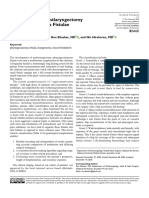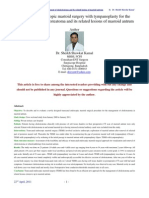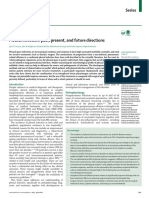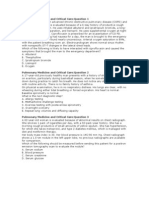Case Report Hofmann2014
Case Report Hofmann2014
Uploaded by
Nurul FahmiCopyright:
Available Formats
Case Report Hofmann2014
Case Report Hofmann2014
Uploaded by
Nurul FahmiOriginal Title
Copyright
Available Formats
Share this document
Did you find this document useful?
Is this content inappropriate?
Copyright:
Available Formats
Case Report Hofmann2014
Case Report Hofmann2014
Uploaded by
Nurul FahmiCopyright:
Available Formats
540811
research-article2014
SRIXXX10.1177/1553350614540811Surgical InnovationHofmann et al
Original Article
Surgical Innovation
Minimally Invasive Vacuum-Assisted
1–5
© The Author(s) 2014
Reprints and permissions:
Closure Therapy With Instillation sagepub.com/journalsPermissions.nav
DOI: 10.1177/1553350614540811
(Mini-VAC-Instill) for Pleural sri.sagepub.com
Empyema
Hans-Stefan Hofmann, MD1,2, Reiner Neu, MD2, Tobias Potzger, MD2,
Rudolf Schemm, MD1, Christian Grosser1, Tamas Szöke, MD1,
and Zsolt Sziklavari, MD1
Abstract
Enthusiasm for minimally invasive thoracic surgery is increasing. Thoracoscopy plays a significant therapeutic role in
the fibrinopurulent stage (stage II) of empyema, in which loculated fluid cannot often be adequately drained by chest
tube alone. For some debilitated and septic patients, further procedures such as open-window thoracostomy (OWT)
with daily wound care or vacuum-assisted closure (VAC) therapy are necessary. In the present article, we propose
a new option of minimally invasive VAC therapy including a topical solution of the empyema without open-window
thoracostomy (Mini-VAC-instill). Three patients who underwent surgery using this technique are also presented. The
discussion is focused on the advantages and disadvantages of the approach.
Keywords
pleural empyema, VAC-instill, minimally invasive thoracic surgery
Introduction Technique
Despite significant advances in the treatment of thoracic Under general anaesthesia, a 5- to 6-cm long incision
infections, pleural empyema remains a problem in mod- centred over the area of the greatest pleural fluid collec-
ern thoracic surgery. If the patient is medically unstable, tion was made (Figure 1A). The intercostal muscle was
the evacuation of pus and debridement can be managed divided, and the empyemal cavity was opened. After the
by open-window thoracostomy (OWT).1,2 Vacuum- intercostal aspiration of all pus and necrotic debris, the
assisted closure (VAC) therapy supports the treatment of cavity was flushed with a polyhexanide solution
acute or chronic wound infections both in general and in (Lavanid 0.02%, Serag-Wiessner KG, Naila, Germany).
thoracic surgery. These benefits include the removal of Then, the VAC sponge (Instill Dressings, KCI Medical,
accumulating fluid, increased oxygen tension in the Wiesbaden, Germany; 400-600 µm) was introduced in
wound, increased blood flow, and increased granulation the pleural cavity over a flexible polymer membrane
tissue proliferation. The combination of OWT and VAC (Alexis, Applied Medical, Rancho Santa Margarita, CA)
therapy should be discussed as soon as possible, espe- retractor (technique described earlier4; Figure 1B and
cially for complicated pleural empyema and in patients C). On the top of the VAC sponge, the VAC instill pad,
with an increased risk for impaired wound healing.3 The including the tubing, was positioned (Figure 1D). The
Mini-VAC procedure offers a minimally invasive
approach with the abdication of an OWT.4 1
Hospital Barmherzige Brüder Regensburg, Regensburg, Germany
In cases of highly infected/bacterial colonised pleural 2
University Regensburg, Regensburg, Germany
empyemas, flushing by a chest tube or the OWT is often
necessary. In this report, we demonstrate that the Mini- Corresponding Author:
Hans-Stefan Hofmann, Department of Thoracic Surgery, Hospital
VAC treatment concept can also be used for the intermit- Barmherzige Brüder Regensburg, Prüfeningerstraße 86, 93049
tent instillation of the pleural cavity through the VAC Regensburg, Germany.
sponge (Mini-VAC-instill). Email: hans-stefan.hofmann@barmherzige-regensburg.de
Downloaded from sri.sagepub.com at UNIVERSIDAD DE SEVILLA on January 13, 2015
2 Surgical Innovation
Figure 1. Technique of Mini-VAC-instill procedure: 5-cm incision over the pleural empyema (A), introduction of VAC sponge
over ALEXIS retractor (B, C), and VAC-instill pad (D). VAC, vacuum-assisted closure.
wound volume determines the amount of fluid instilled. Case Reports
The vacuum device coupled with automated, controlled
antiseptic fluid delivery regulates the instilled fluid vol- The demographic, clinical, and treatment characteristics
ume. The volume of the pleural space was tested and of the patients are given in Table 1.
determined (approximately 150 mL). The level of suc-
tion was set to −100 mm Hg from the start. The flushing
Case 1
of the pleural cavity was performed with a predeter-
mined amount of 0.02% polyhexanide solution A 56-year-old man was diagnosed with pleural empyema
(Lavanid) in an automated topical solution delivery after a third course of palliative chemotherapy for gastric
modus (30 minutes every 8 hours). The patients were cancer stage IV. The pleural space was highly colonized
treated in parallel with wide spectrum antibiotics. Based with Escherichia coli and Bacillus cereus. The decision
on the microbiological results, the spectrum was occa- for quick and complete eradication was made. Because of
sionally modified. The Mini-VAC-instill system was the poor general condition of the patient (Karnofsky
changed every 3 to 4 days. Only a small amount of index 50%), we rejected an extensive surgical procedure
debridement was required at each sponge change. The (decortication). Considering the high bacterial coloniza-
remaining pleural space was, in all cases after the Mini- tion, the Mini-VAC-instill system was implemented.
VAC-instill therapy, very small and only filled with an After eleven days of treatment, the pleural cavity was
aminoglycoside antibiotic gentamicin sponge (Genta- visually determined to be clean, and the patient had 2
Coll resorb, Resorba GmbH, Nürnberg, Germany). negative quantitative cultures. On the 12th postoperative
Downloaded from sri.sagepub.com at UNIVERSIDAD DE SEVILLA on January 13, 2015
Hofmann et al 3
Table 1. Demographic, Clinical, and Treatment Characteristics.
Characteristic Patient 1 Patient 2 Patient 3
Age (years)/gender 75/male 57/male 87/female
Karnofsky index 50 50 40
Multimorbiditya Yes No No
Immunosuppression No Yes (chemotherapy) No
Etiology Primary Primary Secondary
Empyema Stage II Stage II Stage II
Primary intervention Chest tube Chest tube Chest tube
Microbiology Escherichia coli Escherichia coli, Bacillus cereus Staphylococcus aureus
Mini-VAC-instill therapy (days) 5 12 10
VAC-changes 1 3 1
Microbiology after Mini-VAC-instill Sterile Sterile Sterile
Discharge after Mini-VAC-instill 5th day 4th day 7th day
a
More than or equal to 4 chronic diseases.
day, the remaining pleural space was filled with a haemo- cachexia of the patient, and auscultation and percussion of
styptic collagen sponge containing the aminoglycoside the lungs revealed fluid in the left hemithorax. Her arterial
antibiotic gentamicin (Genta-Coll resorb). The wound oxygen saturation at rest while breathing room air was
was closed with single stitches and healed per primam. 90%, and her C-reactive protein level was increased by
The chemotherapeutic treatment of the gastric tumor was more than 100-fold. The CT scan of the thorax showed a
continued after 2 weeks. fracture of thoracic vertebra 8 and both an intraspinal and
stage II pleural empyema (Figure 2A). Antibiotic therapy
with piperacillin/sulbactam was started. The microbiologi-
Case 2
cal diagnosis was Staphylococcus aureus. After a chest
A 75-year-old male patient with a Karnofsky index of 50% tube thoracostomy, thoracic vertebra 8 was dorsally stabi-
presented to our department with recurrent fever that lized by the neurosurgeons. Pus was demonstrated in the
reached as high as 38°C and chills that had lasted for 1 chest tube and in the intraspinal region. The chest tube was
month. He also reported cough, dyspnea, and expectora- flushed with betaisodona 10% thrice per day. Because this
tion. He was an active smoker with a 40-pack-year history treatment failed clinically and on the CT scan control, the
of smoking. Routine laboratory testing showed inflamma- decision to use the Mini-VAC-Instill was made 14 days
tion. The chest X-ray showed a pleural effusion, and the after the neurosurgical operation. The Mini-VAC-instill
chest computed tomography (CT) raised the suspicion of therapy was performed with 150 mL of 0.02% poly-
pleural empyema stage II. The patient underwent a tube hexanide solution, and the VAC sponge was only changed
thoracostomy. Escherichia coli and anaerobic species were once. The pleural cavity was sterile and could be primarily
isolated. The primary drainage treatment failed despite closed on the seventh day after the first installation of the
daily solution changes. The decision to use the Mini-VAC- Mini-VAC. She was discharged from the hospital 5 days
instill was made. The VAC sponge was changed only once. after primary chest closure. After the follow-up at 1 month,
After 5 days of the Mini-VAC-instill treatment with 0.02% no pleural empyema had recurred (Figure 2B).
polyhexanide, the pleural cavity was sterile and could be
primarily closed. The patient was discharged from the hos-
pital on the fifth postoperative day. At the 1-month follow-
Discussion
up, no pleural empyema had recurred. The VAC-instill therapy differs from the standard VAC
treatment in that topical solutions are cyclically flushed
into the foam dressing and held for a user-selected period
Case 3 before removal under negative pressure. Studies have
A 87-year-old woman presented with left inspiratory chest reported on the effectiveness of VAC-instill in wounds
pain in the emergency room. The medical history revealed with high levels of exudate and pus and in acute traumatic
a left thoracotomy for a kyphoplasty of thoracic vertebra wounds or wounds acutely debrided due to infected soft
12 and decompression of the spinal canal three months ear- tissue.5,6
lier. In the past 6 weeks, she suffered with a fever and sig- The bacteriology of pleural empyemas is often poly-
nificant worsening. The physical examination demonstrated microbial and mixed, containing multiple species of both
Downloaded from sri.sagepub.com at UNIVERSIDAD DE SEVILLA on January 13, 2015
4 Surgical Innovation
intended for topical use include topical cleansers, antibi-
otics, antifungals, and antiseptics. Intervals in pleural
flushing (the ebb-and-flow technique) are better than
continuous pleural flushing with standard intervals.9 In
practice, these cycles of flushing are repeated from 4 to
12 times hourly.10,11 According to the present state of
knowledge, polyhexanide is the first-choice antiseptic
solution when using instillation for acutely or chronically
infected wounds (after debridement).12 However, the key
aspect of this therapy is the delivery method of the topical
solution, not the type of solution.
The system should only be exchanged every 3 to 4
days. Thus, daily time-consuming doctor and caregiver
wound intervention is not necessary. The sponge changes
are facile and fast because the Mini-Vac-instill therapy
also enables minimization of intraoperative manual activ-
ities (eg, debridement) by fast cleaning.
The wound should be assessed at every dressing change,
and the decision to continue the Mini-VAC-instill should be
made during this time. We recommend Mini-VAC-instill
therapy only for hospital use because patients are often sep-
tic and infected by multiple species of bacteria. After clean-
ing of the pleural space, conversion to simple Mini-VAC
therapy to bridge to the ambulant sector, with the aim of
further reduction of the pleural cavity, is possible.
Conclusions
Figure 2. Chest CT scan of pleural empyema before (A) and
Standard pleural VAC therapy offers rapid treatment for
after (B) Mini-VAC-instill therapy. CT, computed tomography;
VAC, vacuum-assisted closure. complex pleural empyema. In septic patients with highly
infected/bacterially colonized pleural empyema, we rec-
ommend Mini-VAC-instill therapy. This procedure pro-
aerobic and anaerobic bacteria, with the latter found in up vides intermittent topical solution delivery and removal
to 75% of the cases.7 The diffusion of antibiotics into the from the wound site. Wound cleaning, the removal of
pleural fluid is good, but certain agents may be inacti- infectious material and wound healing are supported by
vated in the presence of pus, low pH, and beta-lactamase this system. The procedure is minimally invasive and
enzymes. In addition to a surgical intervention, flushing highly compatible, especially in patients in poor general
of the pleural cavity by a chest tube is often necessary to condition.
clean the empyemal cavity. If the patient is also medically
unstable, the evacuation of pus and debridement can be Declaration of Conflict Interests
managed traditionally by OWT and daily open wound
treatment, including flushing of the pleural space. The author(s) declared no conflicts of interest with respect to
research, authorship, and/or publication of this article.
The present Mini-VAC-instill therapy (an upgrade of
Mini-VAC) guarantees the advantage of an open treat-
ment, including flushing without OWT. Rib resection for Funding
OWT is associated with more postoperative pain and a The author(s) received no financial support for the research,
muscle flap closure in most cases. authorship, and/or publication of this article.
The decision not to proceed with classical decortica-
tion of the lung appears not to be a disadvantage because References
similar lung reexpansion was achieved by debridement 1. Eloesser L. An operation for tuberculous empyema. Chest.
alone without decortication in patients presenting with 1935;1(8):8-9, 23.
empyema.8 2. Clagett OT, Geraci JE. A procedure for the management of
The Mini-VAC-instill allows pleural cleaning, irriga- postpneumonectomy empyema. J Thorac Cardiovasc Surg.
tion and removal of infectious materials. Solutions 1963;45:141-145.
Downloaded from sri.sagepub.com at UNIVERSIDAD DE SEVILLA on January 13, 2015
Hofmann et al 5
3. Sziklavari Z, Grosser C, Neu R, et al. Complex pleural 8. Kho P, Karunanantham J, Leung M, Lim E. Debridement
empyema can be safely treated with vacuum-assisted clo- alone without decortication can achieve lung re-expansion
sure. J Cardiothorac Surg. 2011;6:130. in patients with empyema: an observational study. Interact
4. Hofmann HS, Schemm R, Grosser C, Szöke T, Sziklavari Cardiovasc Thorac Surg. 2011;12:724-727.
Z. Vacuum-assisted closure of pleural empyema without 9. Engelmann C. Septische Thoraxchirurgie. Berlin,
classic open-window thoracostomy. Ann Thorac Surg. Germany: Pabst Science; 1998.
2012;93:1741-1742. 10. Rosenfeldt FL, McGibney D, Braimbridge MV, Watson
5. Gabriel A, Shores J, Heinrich C, et al. Negative pressure DA. Comparison between irrigation and conventional
wound therapy with instillation: a pilot study describing treatment for empyema and pneumonectomy space infec-
a new method for treating infected wounds. Int Wound J. tion. Thorax. 1981;36:272-277.
2008;5:399-413. 11. Conlan AA, Abramor E, Delikaris P, Hurwitz SS. Taurolidine
6. Gabriel A, Shores J, Bernstein B, et al. A clinical review instillation as therapy for empyema thoracis. A prospective
of infected wound treatment with vacuum assisted closure study of 50 patients. S Afr Med J. 1983;64:653-655.
(V.A.C.) therapy: experience and case series. Int Wound J. 12. Kramer A, Assadian O, Below H, Willy C. Wound anti-
2009;6(suppl 2):1-25. septics today—an overwiew. In: Willy C, ed. Antiseptics
7. Hughes CE, Van Scoy RE. Antibiotic therapy of pleural in Surgery—Update 2013. Berlin, Germany: Lindqvist
empyema. Semin Respir Infect. 1991;6:94-102. Books; 2013:83-110.
Downloaded from sri.sagepub.com at UNIVERSIDAD DE SEVILLA on January 13, 2015
You might also like
- Anatomy and Physiology of The AirwayDocument42 pagesAnatomy and Physiology of The Airwayiaa100% (2)
- Robotic Hernia Surgery: A Comprehensive Illustrated GuideFrom EverandRobotic Hernia Surgery: A Comprehensive Illustrated GuideOmar Yusef KudsiNo ratings yet
- Geriatric Case StudyDocument15 pagesGeriatric Case StudyJobelle Acena100% (1)
- Respiratory SystemDocument42 pagesRespiratory Systemapi-87967494100% (2)
- TAPP HernioplastyDocument5 pagesTAPP HernioplastyMaryam Alam KhanNo ratings yet
- Canalplasty For Exostosis With Maximal Skin PreservationDocument9 pagesCanalplasty For Exostosis With Maximal Skin PreservationAbegail LacsonNo ratings yet
- The Analysis of Computed Tomography of Paranasal.99Document5 pagesThe Analysis of Computed Tomography of Paranasal.99Luciana MunhozNo ratings yet
- Thoracic Empyema: A Jaffé, G Cohen A Role For Primary Video Assisted Thoracoscopic Surgery ?Document3 pagesThoracic Empyema: A Jaffé, G Cohen A Role For Primary Video Assisted Thoracoscopic Surgery ?Hafshah SumayyahNo ratings yet
- TEP or TAPP - Who, When, and HowDocument8 pagesTEP or TAPP - Who, When, and HowVersatile Media MUANo ratings yet
- Endoscopy-Assisted TotalDocument8 pagesEndoscopy-Assisted TotaltiaoyueasplNo ratings yet
- Transversus Abdominis Plane Block For Laparoscopic SurgeryDocument2 pagesTransversus Abdominis Plane Block For Laparoscopic SurgeryFitri Kasmita SariNo ratings yet
- 17 Dirckx, Wound TherapyDocument3 pages17 Dirckx, Wound TherapyTor ChiuNo ratings yet
- Thoracic Segmental Spinal Anesthesia Case ReportDocument5 pagesThoracic Segmental Spinal Anesthesia Case Reportsurgery AVPMNo ratings yet
- Endofistula Laser Ablation of Fistula-In-Ano - A New Minimally Invasive Technique For The Treatment of Fistula-In-AnoDocument6 pagesEndofistula Laser Ablation of Fistula-In-Ano - A New Minimally Invasive Technique For The Treatment of Fistula-In-AnoagusNo ratings yet
- Aneurysmorrhaphy (Eng)Document14 pagesAneurysmorrhaphy (Eng)Harlan IdrisNo ratings yet
- 4 Kuratani2008Document5 pages4 Kuratani2008M RidwanNo ratings yet
- Anaesthesia For OMF SurgeryDocument5 pagesAnaesthesia For OMF Surgeryranjitha.droidNo ratings yet
- 801038-2015_06-en_SERATIM-leafletDocument8 pages801038-2015_06-en_SERATIM-leafletandreea.arpinNo ratings yet
- Comparison of Endoscopic Vacuum Therapy Versus Stent For Anastomotic Leak After EsophagectomyDocument7 pagesComparison of Endoscopic Vacuum Therapy Versus Stent For Anastomotic Leak After EsophagectomySergio Sitta TarquiniNo ratings yet
- Condilectomia Intra OralDocument7 pagesCondilectomia Intra OralJuan Carlos MeloNo ratings yet
- Anitua 2013Document9 pagesAnitua 2013Paul CerdaNo ratings yet
- Petersson Et Al 2018 Vacuum Assisted Wound Closure and Permanent Onlay Mesh Mediated Fascial TractionDocument11 pagesPetersson Et Al 2018 Vacuum Assisted Wound Closure and Permanent Onlay Mesh Mediated Fascial Tractioncore6406No ratings yet
- Iranjradiol 14 03 21742Document5 pagesIranjradiol 14 03 21742AisahNo ratings yet
- Perioperative Nursing: Preoperative PhaseDocument5 pagesPerioperative Nursing: Preoperative PhaseanjieNo ratings yet
- Management of Nasolabial Cysts by Transnasal Endoscopic MarsupializationDocument8 pagesManagement of Nasolabial Cysts by Transnasal Endoscopic Marsupializationfk06No ratings yet
- Use Only: Intracorporeal Hybrid Single Port Conventional Laparoscopic Appendectomy in ChildrenDocument4 pagesUse Only: Intracorporeal Hybrid Single Port Conventional Laparoscopic Appendectomy in ChildrenYelisa PatandiananNo ratings yet
- Ijog 02 00012Document4 pagesIjog 02 00012okarnaukh34No ratings yet
- Rosadocobin 2017Document9 pagesRosadocobin 2017Chema ToledoNo ratings yet
- Posterior SeptotomyDocument10 pagesPosterior Septotomyaxel pqNo ratings yet
- Yang 2019Document6 pagesYang 2019Imron BuhoriNo ratings yet
- Klasifikasi PCFDocument2 pagesKlasifikasi PCFmikhaelyosiaNo ratings yet
- Egyptian Journal of Ear, Nose, Throat and Allied SciencesDocument5 pagesEgyptian Journal of Ear, Nose, Throat and Allied SciencesLuis De jesus SolanoNo ratings yet
- Laparoscopic Cholecystectomy Perioperative Management: An UpdateDocument5 pagesLaparoscopic Cholecystectomy Perioperative Management: An UpdateNurlailah AliNo ratings yet
- #x2018 Short Bars Crossed’ To Remodel TheDocument6 pages#x2018 Short Bars Crossed’ To Remodel Thesensation sex shopNo ratings yet
- The Negative Pressure Wound Therapy For Flap SalvageDocument9 pagesThe Negative Pressure Wound Therapy For Flap SalvageInternational Journal of Innovative Science and Research TechnologyNo ratings yet
- Common Postoperative Findings Unique To Laparoscopic SurgeryDocument21 pagesCommon Postoperative Findings Unique To Laparoscopic SurgeryMoises MolinaNo ratings yet
- AkjsijdijsDocument8 pagesAkjsijdijsShafira LusianaNo ratings yet
- Minimally Invasive Thoracic SurgeryDocument9 pagesMinimally Invasive Thoracic SurgeryLEONEL ALFREDO GUILLEN MARINNo ratings yet
- Comparison of A Supraglottic Gel Device and An Endotracheal Tube in Keratoplasty Performed Under General Anesthesia: A Randomized Clinical TrialDocument4 pagesComparison of A Supraglottic Gel Device and An Endotracheal Tube in Keratoplasty Performed Under General Anesthesia: A Randomized Clinical TrialJoseph Chipana GutierrezNo ratings yet
- Minimal Access Surgery in Children - 5 Years Institutional ExperienceDocument8 pagesMinimal Access Surgery in Children - 5 Years Institutional ExperienceGunduz AgaNo ratings yet
- 1 s2.0 S1522294220300386 MainDocument31 pages1 s2.0 S1522294220300386 Mainhafidisara05No ratings yet
- Advantages Disadvantages Indications Contraindications of LMADocument7 pagesAdvantages Disadvantages Indications Contraindications of LMAinaromantinNo ratings yet
- Ahmed 2016Document6 pagesAhmed 2016AYŞE GÜLŞAH ATASEVERNo ratings yet
- Vitrectomy Surgery For Primary Retinal DetachmentDocument8 pagesVitrectomy Surgery For Primary Retinal DetachmentAvluz AdiansuhNo ratings yet
- Shaggy 18Document2 pagesShaggy 18Eghet SilviuNo ratings yet
- Aaos Elbow Surgical Approaches-1Document9 pagesAaos Elbow Surgical Approaches-1Mossa SultanyNo ratings yet
- Lateral Rhinotomy and Medial Maxillectomy ApproachDocument5 pagesLateral Rhinotomy and Medial Maxillectomy ApproachNuhu Bankwhot100% (1)
- Mero PackDocument6 pagesMero PackKshitiz KlNo ratings yet
- Transcanal Endoscopic Mastoid Surgery With Tympanoplasty For The Management of CholesteatomaDocument8 pagesTranscanal Endoscopic Mastoid Surgery With Tympanoplasty For The Management of CholesteatomaShawkat Kamal100% (1)
- Trocar Site Closure With Omental Plug Insertion in Laparoscopic Bariatric Operations: Efficacy, Safety, and OutcomesDocument6 pagesTrocar Site Closure With Omental Plug Insertion in Laparoscopic Bariatric Operations: Efficacy, Safety, and OutcomesIJAR JOURNALNo ratings yet
- The Bilateral Pedicled Epilated Scrotal Flap: A Powerful Adjunctive For Creation of More Neovaginal Depth in Penile Inversion VaginoplastyDocument8 pagesThe Bilateral Pedicled Epilated Scrotal Flap: A Powerful Adjunctive For Creation of More Neovaginal Depth in Penile Inversion VaginoplastySexologia Del OesteNo ratings yet
- Exemplu 4Document4 pagesExemplu 4Pavel SebastianNo ratings yet
- Novel Technique For Safe Primary Trocar InsertionDocument5 pagesNovel Technique For Safe Primary Trocar InsertionPrameita Rahmawati MITNo ratings yet
- Operasi MetodeDocument4 pagesOperasi MetodeImam S BluesNo ratings yet
- Intracameral Mydriatics Versus Topical Mydriatics in Pupil Dilation For Phacoemulsification Cataract SurgeryDocument5 pagesIntracameral Mydriatics Versus Topical Mydriatics in Pupil Dilation For Phacoemulsification Cataract SurgeryGlaucoma UnhasNo ratings yet
- 2023 Apr - Pre Clinical Evaluation of APrevent VOIS For Unilateral Vocal Fold ParalysisDocument8 pages2023 Apr - Pre Clinical Evaluation of APrevent VOIS For Unilateral Vocal Fold ParalysisemilylinNo ratings yet
- Joseph 2016Document1 pageJoseph 2016nadaNo ratings yet
- Document From IndraDocument10 pagesDocument From IndraShiva pNo ratings yet
- Medicine: Observational StudyDocument8 pagesMedicine: Observational StudyAlin Ionut BurlacuNo ratings yet
- Four Cases of Preauricular Fistula Based On Systematic Review Resulted New AlgorithmDocument10 pagesFour Cases of Preauricular Fistula Based On Systematic Review Resulted New AlgorithmMuhammad Dody HermawanNo ratings yet
- Diaphragm Ultrasonography in Icu Why How and When To Use ItDocument6 pagesDiaphragm Ultrasonography in Icu Why How and When To Use ItJAKIN IRINA SANCHEZ URIBENo ratings yet
- PIIS0015028218300323Document12 pagesPIIS0015028218300323Dayra AnnethNo ratings yet
- Jurnal Laryngeal TraumaDocument7 pagesJurnal Laryngeal TraumaadindaNo ratings yet
- CTT CareDocument76 pagesCTT CareMarites Santos AquinoNo ratings yet
- 1.2. PneumothoraxDocument42 pages1.2. PneumothoraxFarahRullyta100% (1)
- RTS1-K13-Anatomy of LungsDocument22 pagesRTS1-K13-Anatomy of LungsYohanna SinuhajiNo ratings yet
- 聲音研究Document54 pages聲音研究roselee0214No ratings yet
- Serous Fluid Powerpoint HandoutDocument3 pagesSerous Fluid Powerpoint HandoutAnonymous ceYk4p4No ratings yet
- Lung and Airway Ultrasound in Pediatric AnesthesiaDocument7 pagesLung and Airway Ultrasound in Pediatric Anesthesiaema moralesNo ratings yet
- Body Fluid 3 MethodDocument5 pagesBody Fluid 3 MethodSyofian Dedi SiregarNo ratings yet
- Full Download of Test Bank for Visual Anatomy and Physiology, 1st Edition: Frederic H. Martini in PDF DOCX FormatDocument53 pagesFull Download of Test Bank for Visual Anatomy and Physiology, 1st Edition: Frederic H. Martini in PDF DOCX Formatmanwarhaizal100% (3)
- Case Study (Document3 pagesCase Study (Hashimi KachukoNo ratings yet
- Pleural Manometry: Techniques, Applications, and Pitfalls: Kurt Hu, Amit Chopra, John Terrill Huggins, Rahul NanchalDocument12 pagesPleural Manometry: Techniques, Applications, and Pitfalls: Kurt Hu, Amit Chopra, John Terrill Huggins, Rahul NanchalharbiNo ratings yet
- Development of Respiratory SystemDocument34 pagesDevelopment of Respiratory SystemNatalie HuiNo ratings yet
- A Practical Approach To Pseudoexudateve Pleural EffusionsDocument5 pagesA Practical Approach To Pseudoexudateve Pleural EffusionsvillaboyNo ratings yet
- Pleural Effusions: Can-Mao XieDocument42 pagesPleural Effusions: Can-Mao XieHassan AhmadNo ratings yet
- Chapter 12Document42 pagesChapter 12Zabu CastilloNo ratings yet
- Pleural Infection - Past, Present, and Future DirectionsDocument15 pagesPleural Infection - Past, Present, and Future DirectionsCamilo VidalNo ratings yet
- Tension PneumothoraxDocument20 pagesTension PneumothoraxMichael WijayaNo ratings yet
- Macro PneumohemoDocument28 pagesMacro PneumohemoSiti AishahNo ratings yet
- Casi Clinici Medicine and Critical CareDocument85 pagesCasi Clinici Medicine and Critical CarePaolo OnidaNo ratings yet
- Radiology Total 1Document161 pagesRadiology Total 1Jazz zNo ratings yet
- Thoracic Surgery LobectomyDocument21 pagesThoracic Surgery LobectomyJane SharpsNo ratings yet
- Pulmonary Edema: Nuala J. Meyer,, - Michael A. MatthayDocument33 pagesPulmonary Edema: Nuala J. Meyer,, - Michael A. MatthayRaul JimenezNo ratings yet
- Handout AtelectasisDocument14 pagesHandout AtelectasisSasha IfahmyNo ratings yet
- Jurnal CardioDocument5 pagesJurnal CardiotiaanastaNo ratings yet
- Empyema: An Uncommon Complication of Common Pneumonia: Heather Hsu, HMS III Gillian Lieberman, MDDocument0 pagesEmpyema: An Uncommon Complication of Common Pneumonia: Heather Hsu, HMS III Gillian Lieberman, MDAldo EmeraldNo ratings yet
- Alok Sinha Department of Medicine Manipal College of Medical Sciences Pokhara, NepalDocument46 pagesAlok Sinha Department of Medicine Manipal College of Medical Sciences Pokhara, NepalAnnushika PalanichamyNo ratings yet
- Almaghrabi Resp ExaminationDocument33 pagesAlmaghrabi Resp ExaminationSagit Nauman81100% (1)
- 2011 Krok Bank SurgeryDocument31 pages2011 Krok Bank SurgeryRahul PatilNo ratings yet

























































































